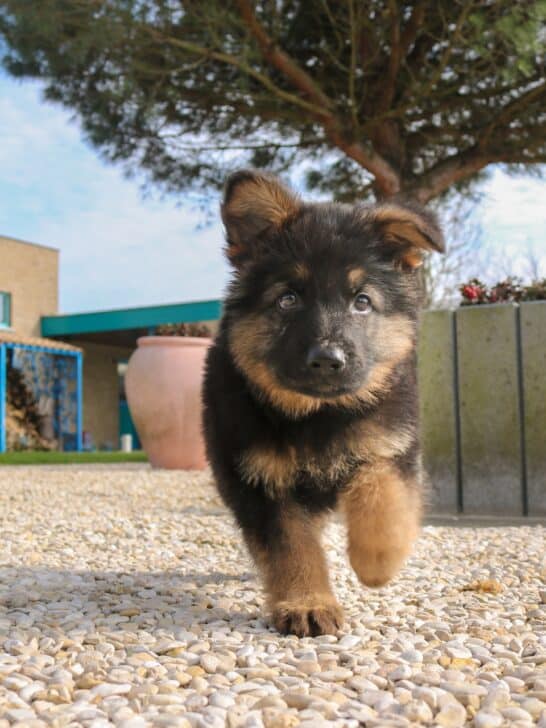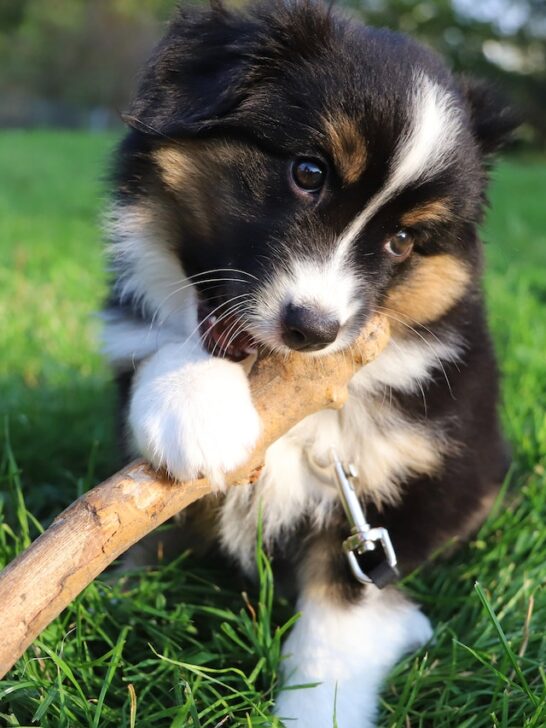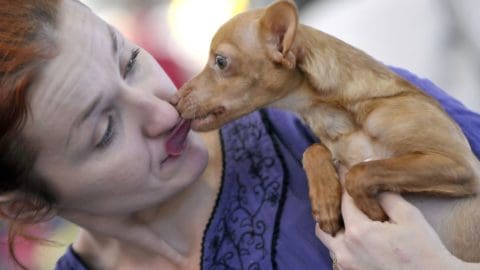How to Understand a German Shepherd’s Body Language
Every animal is capable of displaying their emotions through either vocalization, body language, or both.
Many animals will use both sound and body language to let each other know how they are feeling.
Birds will use their feathers and vocalizations to let other birds know how they feel, cats might meow and fluff up their fur.
Dogs, including German Shepherds are the same, a dog may either vocalize by barking, or they may use body language to communicate how they are feeling.
Much like us, they can use their bodies to denote emotions and feelings. If we are feeling sad we will often ‘look’ sad, dogs can do the same.
Think about how you relate a dog wagging their tail to excitement or happiness.
Not every emotion in dogs is quite as easy to read as a good old tail wag.
Dogs, your German Shepherd included, may use more subtle cues that will let you know how they are feeling.
These will not be as easy to understand for the untrained eye. Similarly, not all German Shepherd Dogs will display body language that is what it seems to be.
That is why we have put together this collection of information today, a perfect guide to assist you in understanding what your German Shepherd is trying to let you know with their body language.
German Shepherds can not speak to tell us how they are feeling, so, it’s about time that we meet them halfway in their efforts to communicate with us, and learn what their body language might mean.
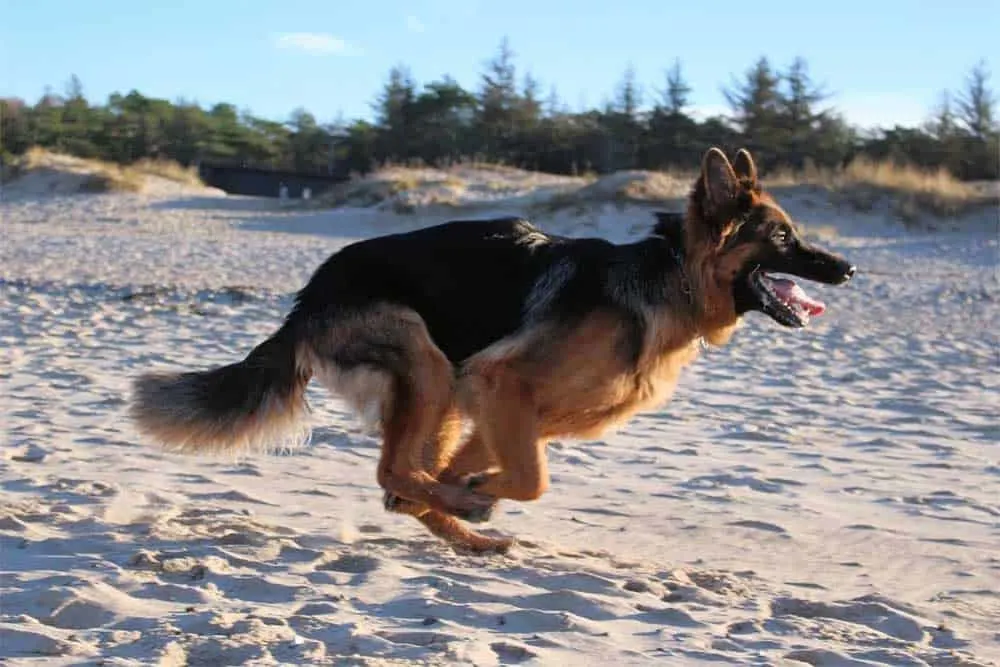
German Shepherds- A world through their eyes
The eyes are the window to the soul, perhaps not in quite such a literal sense, however, eyes are incredibly good at showing emotions, yes, even in German Shepherds.
Some of their most subtle, and not so subtle cues for how they feel, will be communicated through their eyes.
A majority of emotions that a German Shepherd will show through their eyes will relate to stress, anxiety, and a precipitation to biting.
It is important that if you have a German Shepherd dog, or if you randomly come across someone else’s German Shepherd that you understand what their eyes are telling you.
Understanding if their eyes look stressed, anxious, or potentially like they are ready to attack, it can give you the ability to fix a stressful situation for the dog, or it could even prevent you from receiving a painful bite.
Squinting and slow blinking
This behavior may seem weird, or even stressed, however, if your German Shepherd is doing this then it will likely mean one of two things.
It can mean that your dog is hungry for your attention, or it may mean that he is trying to relax or trying to get others around him to relax.
If you do notice this type of behavior then try to conclude if they wish to have your attention, or if they are seeking a moment of zen for themselves and those around them.
If anything, this behavior is a symbol of stress, meaning your dog is not too happy or comfortable with the actions of the people or animals around them.
Try to help them feel more comfortable and assist them in relaxing.
Staring and hard focusing
If your German Shepherd is staring intensely and focusing hard, then it is time you take notice and pay attention to what is happening with the dog.
This behavior is a big red flag.
Typically, this is the only real warning that you will get before the dog attacks to bite.
It is found a lot when dogs are stressed, or afraid, it is their way of saying “Go away!”
Keep in mind their stare may not always be pin-pointed towards people or other animals, but sometimes toward an object that they are guarding.
Think about a dog who dug up a bone and now treasures it, or their favorite toy which they may be defensive over, they may growl and stare, maybe not even at you, but at the bone. Protecting it.
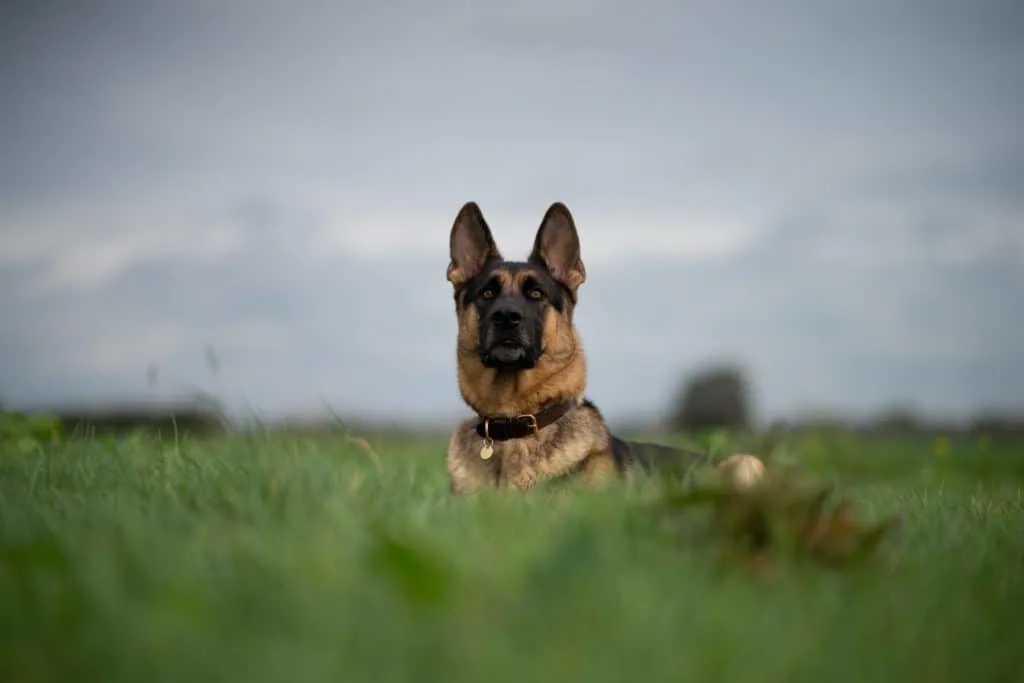
“Whale eyes”
This happens when your German Shepherd is looking in a different direction than the one in which their head is pointed.
In the white of their eyes, you will see a large crescent moon shape.
This is an indication of them being stressed, afraid, or feeling anxious. What your dog is saying is “Please give me space and time right now.”
If you notice this behavior in your dog, the best thing that you can do is figure how you can better alter the situation to accommodate your dog and make them feel at ease once more.
This could mean that you need to remove your dog from the situation they are currently in.
Or, if it is not your dog, then calmly and slowly removing yourself from the situation may be the remedy.
Out of context dilation of pupils
When we are in low lighting conditions, your pupils will dilate, the same thing happens for dogs too. It is only natural.
However, if your dog’s eyes dilate in a brightly lit environment, such as if you are outside on a sunny day, or if you are in a brightly lit room, then this means something totally different.
If lighting levels are not low and their eyes have dilated, then this could actually be a sign that they are stressed, anxious, or overly-aroused.
If your dog’s pupils are frequently dilated out of context to the current lighting, then this could be further cause of concern as this may be a sign of a medical issue, and you should seek out a vet.
Darting around
This might just look like it is your dog just checking out their surroundings. However, this is a bit beyond that.
For example, if you take your dog out on a regular walk in a familiar environment then it will be natural for them to take in all of their surroundings.
Your dog will naturally be curious about their surroundings, checking out animals and people that they come across.
You need to understand and be able to distinguish the difference from this normal curious eye behavior from darting eyes.
In the instance that your dog is darting their eyes around, you will notice that there is a bit more going on than just your dog observing their surroundings.
Darting eyes are a sign of stress, this will most likely be something that occurs in new or unfamiliar environments such as a vet’s office, or when you take them for a walk in a new place.
Your dog is hyper-vigilant, not focusing on any one important thing, instead they will be visibly tense.
If that happens, or when it happens, this is a cue for you to do whatever you can to change the environment, slow things down, or do your best to help comfort your dog.
If this is something that occurs when you are out walking, then just slow down, or stop for a few minutes.
Sometimes just stopping and sitting together for a few minutes can be all that is needed to calm down whatever is stressing out your dog.
It could also happen if you are on a planned outing with your dog, such as a beach trip where there may be many other people and animals there.
While it is important that you socialize your dog and help to introduce him to new environments as much as you can, you need to ensure that you do this in a way that doesn’t stress your dog out.
Of course, this requires some discretion on your behalf, you know your dog best after all.
If your dog seems to be more tense than usual in these situations, then perhaps it is best to air on the side of caution, or change your plans.
You can always use comfort items, such as toys, blankets, or pillows, as some dogs may have these.
If your dog gets especially anxious in new places, comfort items are a good thing to take with you so that your dog has something to turn to.
In some cases, you could simply revisit the situation with your dog, we get good days and bad days, dogs are the same.
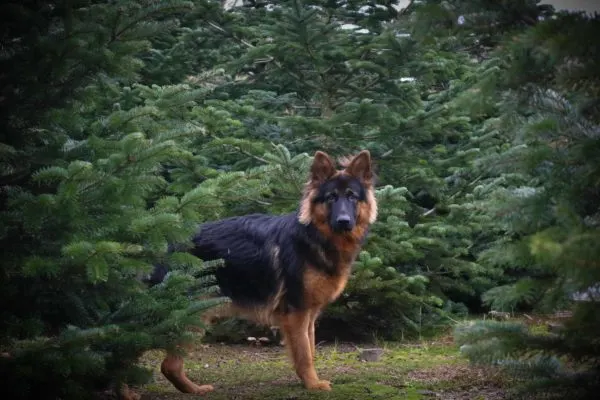
German Shepherds – Reading their ears
All dogs have awesome hearing, however, German Shepherds have an acute auditory sense, it’s just how they were bred.
They need to hear well to stay vigilant and on alert when they are guarding herds and properties.
German Shepherd ears are large and rigid so that they allow for maximum sensitivity to even the most subtle of noises.
The shape of the German Shepherd’s ears will also offer a very distinct advantage to you as the owner.
It is much easier to notice even the most subtle cue of how your dog feels, just based on what they are doing with their ears.
So, what are these German Shepherd ear behaviors, and how can you translate them into understanding how your dog is feeling?
Forwards
If your dog’s ears are forward, then it is a sign that your German Shepherd is alert and listening intensely.
If their ears are tilted this way, this also means that your dog is feeling confident, which is very good.
When a dog feels confident, it can be visually evident as it would be in a person.
There is a particular demeanor that is apparent when confidence is present.
Having their ears positioned forwards is just a small part of the larger picture of confidence.
Backwards
If you notice that your dog’s ears are pinned backwards, especially if it is almost in a rigid way, then take note of this.
If their ears are pinned back in this way, then it is a sign that your dog is fearful or anxious.
Relaxed
If your dog’s ears seem to be relaxed then it is exactly how it looks.
If your German Shepherd’s ears look relaxed and flopped back, then this is also exactly how your dog is feeling.
Ahh, relaxation.
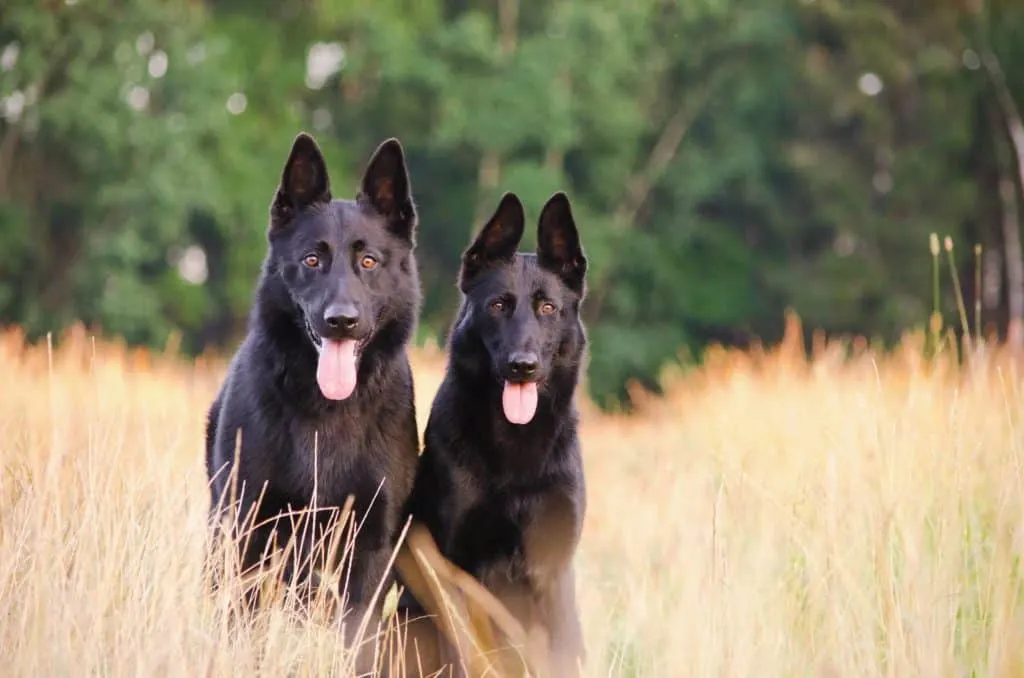
Directional Change
When your German Shepherd’s ears are tilted in different directions, this is a sign that they are listening to multiple different sounds all at once.
German Shepherds can do this, focusing their attention on several different sounds all at the same time.
They will often be looking in one direction, with their ears also tilting in different directions simultaneously.
This will often be noticed the most when you are outdoors, if there are a lot of things going on outdoors, then there may be a lot to listen to; cars, people, animals, and so on.
If you notice this, then give your surroundings a quick scan over.
Get yourself in tune with anything that has the possibility of stressing out your dog.
This will ensure that you are not met with anything that may come as an unwelcome surprise.
Ears Down
It is possible for German Shepherds to end up with floppy ears, and not the classic erect ears that this breed is known for.
But if a German Shepherd with standard ears suddenly lowers their ears, this is likely a sign of some sort of stress.
This will look like their ears are flattened and stick to the sides of their head.
When this happens, the dog is probably feeling uneasy about something in their environment.
This could be a strange animal or person nearby, or even an underlying health issue like an illness or injury.
When this is the case, look for other signs that your dog isn’t feeling well, like cowering or hunching over, and whimpering or crying.
If you notice signs like these, along with your German Shepherd’s ears down, then you know for sure that something is bothering them.
German Shepherds- Mood via the mouth
Dogs’ mouths and tails are two of the most common ways to tell how a dog feels, as these are often the most expressive.
However, telling how your dog feels via their mouth can be a bit difficult, as the same posture can often have similar oppositional meanings.
So, we will explain all of the possible meanings of a certain expression, however, you need to make sure that you are familiar with your dog to therefore learn how they are feeling through your own observations and familiarity with them.
No one will know your dog better than you, so you are the best person to interpret your dog’s behavior.
You can use our guidelines as a reference point, but do not forget to also apply your own knowledge about your dog to understand what these mouth movements mean more accurately.
Open Mouth
A German Shepherd with their mouth open can be a signifier of two things, they could either be stressed, or relaxed.
The most key thing to notice with an open mouth is change. What we mean by this is if your dog’s mouth goes from partially open to very suddenly closed.
This behavior would be an example of stilling behavior, if they do this, not only will their mouth become still, but their whole body will follow suit.
This is simply a sign that something has caught their attention. If you take a look around you will most likely see what they are focusing on.
Close Mouth to Open Mouth
If you notice that your dog’s mouth has gone from closed to open, then this can be an indicator of possible stress.
Listen closely and look around. See if there is anything around that could be causing stress to your dog.

Panting
The general assumption about panting is that dogs only do it when they are hot, or if they are recovering from exercise.
While this may be possible, and if often most likely the case, you should take all possibilities into account, considering the context in which your dog is panting.
What we mean is, if your dog has been running about on a hot day, then they begin panting, this just means that they are a bit hot and tired. Panting to release excess heat from their body.
If your dog is panting, and there are no external reasons, such as heat or exertion, then you should pay attention.
Panting without any heat or exercise as a cause, can be a sign of stress, over-arousal, or excitement. If this is the case for your dog, then the panting will often most likely be accompanied by some drool as well.
Some dogs will drool quite a bit when they are stressed.
You can often notice this when you are taking your dog to see the veterinarian.
You may think that in situations like these, your dog is feeling car sick, however, this is actually a stress reaction, dogs can be aware that they are going to the vet’s office.
Or if it is their first time in a car this can be scary, German Shepherds are not alone in this, other dogs will pant when they are stressed, even cats do it too.
In instances where it is a little more difficult to tell if the panting is due to stress or otherwise, you should pay attention to their tongue shape.
If a dog is overheated and is trying to cool down, then the tongue will just hang there, and bob up and down gently with their breath.
If the panting is due to stress, the tongue will look different. The name for this is ‘spatulate’, because it looks a bit like a spatula.
The tongue will hang down and then have a concave curve across its width, usually pointing up at the end. This is easy to distinguish from an unstressed tongue.
Huffs and sighs
If you hear your dog huffing or sighing, think about situations in which you do this. Your dog might do this after a stressful event, as a sigh of relief.
You can actually use this behavior to pin-point what things are likely to cause stress to your dog, so that you can avoid them in the future.
As an example, if you were to take your dog to an unfamiliar place, then they let out a huff or sigh after you leave, then you can be certain that your dog did not like that place, and it stressed them out.
Now you know not to take your dog there in the future.
Snarling
If your dog snarls, or if they raise their lip, then this is a sign that they are feeling unsettled or uncomfortable. This is essentially a warning to back off, and give them some space.
When your German Shepherd’s mouth takes a position of snarling, or raising their lip, then this is a sign that they are preparing to snap at the person that they are doing this in relation to. They may even bite.
This is a sign that should be taken seriously, and you need to consider what you can do to defuse the situation at hand.
In a majority of cases this will be that if the dog is being pet, that you should then calmly and slowly stop the action of petting them and then give the dog some space.
Do not move quickly as if they are already on edge; this may lead them to react quickly.
However, it is also possible that the dog may have its lip curled, like a smile. This would not mean that they are feeling aggressive, instead, they are feeling submissive.
Many dog owners may say that this is a ‘smile’ and might relate it to when we smile.
However, this is not the same, the dog is not expressing joy or happiness, but, they are not expressing any aggression or anger either. Instead, they are relaxed and are expressing the act of being submissive.
The action of this ‘smile’ will often be accompanied by relaxed ears and an overall calm demeanor.
Yawning
Yawning can mean a selection of things for German Shepherds.
First of all, they may yawn for the same reason that we do. In this respect dogs are just like humans are, they will yawn when they are tired, or when their bodies need more oxygen,
That being said, yawns can also be a sign of stress, conflict, and anxiety.
They may yawn to tell you that they are starting to find things are a bit overwhelming, and they want a change in their current situation in order to calm things down a bit.
An easy way that you can tell why your dog is yawning is to simply pay attention to their surroundings.
If you are in a familiar place, such as your home, and you are just chilling out and relaxing after a long day, then your dog’s yawns may mean that they are just as tired as you are, and it is time to head to bed soon.
Yet, if you are somewhere that is not familiar in the middle of the day.
If you are in the company of new, or unfamiliar people and animals, then a yawn from your dog is probably a sign that they are feeling a bit stressed.
Stress related yawns in German Shepherds are also typically longer and more exaggerated than a regard tiredness-based yawn.
You may also find your German Shepherd will vocalize when they yawn, however this varies depending on the dog’s personality.
You should always pay attention to your dog when they give you these cues. Generally, people ignore these cues simply because they have no idea what they are looking for.
However, when you learn and understand how your dog yawns, then it will be easy to understand their cues in the future, and you will be able to identify when you are in a situation that your dog wants to be addressed, or if your dog is happy being left alone.
Lip licking and tongue flicking
Lip-licking is a sign of stress. These licks can be tiny and quick, or they can be full and exaggerated along all sides of the mouth. If it is stress related they may be trying to tell you a few things.
- “I want you to leave me alone.”
- “Please give me space.”
- “I am feeling that you are pressuring me.”
- “I’m very worried.”
- “Back away!”
- “I’m feeling confused, I do not know what you want.”
Similar to pretty much every other behavioral sign, context is imperative to better understand these things. You should remember if you are holding food in front of your dog, and they are licking their lips, it is not stress-related.
If you are not holding some food, and your dog is licking their lips rather pronounced, or if they are excessively licking their lips then this is a sign of stress.
Be sure to evaluate the surroundings and try to conclude if there is anything around you and your dog that may cause stress-related lip licking.
Appeasement licking
Does your dog like to lick you? Do you try to find it frustrating?
Some owners do, and they will typically try to correct this licking using negative reinforcement. However, negative reinforcement gets you nowhere.
Dogs lick for appeasement, hence why it is called appeasement licking, so the chances are that when your dog is licking you for appeasement, and you respond with negative reinforcement, this behavior will only get worse.
Appeasement licking is simply your dog trying to let you know that they want you to accept them. They want to bond with you, and licking is an instinctual way that dogs show their intention.
The best way to respond to this is to affirm the acceptance and bonding, let them know they do not need to click you to show they want this.
Do remember that not all licking is for appeasement.
If you have been to the gym, or for a run, and you are sweaty and sticky, your dog might lick you because they like how the salt in your sweat tastes. (Sounds gross, but they actually do like it.)
German Shepherds – Feelings through their fur

We all know German Shepherds are big shedders. Their fur will shed in every place in the house, and you can expect to find it in places you never thought fur could get to.
However, the fur on your German Shepherd can also be a good indicator of how your dog feels.
So, it is time to look at how your dog’s fur can tell you about their moods.
Shedding
While we all know that German Shepherds shed a lot, and this is normal, there are cases where they are shedding much more than they should.
This is usually the case when they are experiencing stress or fear.
A good example of this can be seen all over the veterinarian’s office.
You will probably have noticed that your dog has shed an obscene amount of fur all over the place while your vet is checking out your dog, this is simply because your German Shepherd is stressed out.
This might also occur in the waiting room to enter the examination room.
When you next take your dog to see the vet, run your hand along their back, if your dog is afraid, you will probably notice that you will end up with a crazy amount of fur in your hand.
This is just stress. In cases like a trip to the vet, this is not always avoidable, however, you can do your best to minimize these situations in which this may occur.
Dander
We all know dander, we know it as dandruff though.
It is just tiny, microscopic flecks of skin. If the dander on your dog is related to stress, then it will occur suddenly, much like stress related shedding.
It is also possible that dander can happen due to fear. You need to be aware of how quickly this can come on.
We, as humans, often relate dandruff to dry skin, however, with German Shepherd this will simply appear out of thin air, if it is due to stress or fear.
Standing on end
When your German Shepherd dog has fur standing on end this is something called “piloerection”, or “hackles”.
When dog owners see this happen with their German Shepherd they automatically assume that the dog is in a heightened state of aggression.
This can be true in part, yet, it can also occur if the dog is afraid, or if they are aroused.
It is possible that this can happen if they are sensing that conflict will soon occur, oftentimes this is in reference to another dog.
Depending on the dog, the hair that is standing up on end may only be above the withers of the dog, which is at the base of the neck and above the shoulders, it could also be down their whole back, or just in portions here and there and long their back.
Give their surroundings a quick scan to try and see what triggered this, it may give you a better idea as to why this is happening.
German Shepherds- Temperament through the tail
When you are looking to find out how your German Shepherd is feeling by checking out their tail, ensure that you base your observation on the base of their tail, not the tip or length.
German Shepherd tails have the potential to be bushy, especially with the longer-haired varieties of this breed, so it can be a bit difficult to understand what exactly the tail is doing if you seek subtle hints.
Looking at the base gets rid of this complication, and you can more easily detect subtle movements.
Wagging
The one movement we all know is tail wagging, however, we often assume that tail wagging automatically means that a wagging tail is a happy tail.
Once again it is similar to understanding the context of the situation. If you are in a situation where your dog is most likely to be happy then the wag is due to happiness.
If he is wagging his tail in a situation that is otherwise, this may signify that they are stressed out.
High hanging
German Shepherds have a few different reasons for having a tail positioned high. These things could be; aggression, arousal, an eagerness to play, or an eagerness to breed.
Regardless of the reason that a German Shepherd may have their tail held high you can simply be aware that it is a symbol that they are interested in something of some sort.
Figuring it out can be done simply by looking around. If there are other male dogs around and this happens, you can be more certain that it is an aggressive response.
However, if there are female dogs around then this response is likely an eagerness to breed. This can work vice versa.
Female dogs are less likely to be aggressive toward other dogs when it comes to breeding than males, although this depends on your dog.
Low hanging
Low hanging tails typically indicate relaxation. In this situation you will generally notice that your dog’s entire body and demeanor is typically relaxed.
With German Shepherds, a low-hanging tail does not necessarily mean that it must be hanging straight down.
You should look at the base of the tail in this instance to differentiate between a slightly tucked tail and a low hanging tail.
If the tail is slightly tucked, then there will be a bit more of an immediate downward slope from the base of the tail, instead of a generally low hanging tail, which in German Shepherds would be indicated by a more gradual or straight line from the base of the tail.
Tucked tail
Another well known tail movement is the tucked tail.
The majority of times in German Shepherds a tucked tail is an indicator that they are feeling afraid, submissive, or just generally uncomfortable with the situation or surroundings.
The most important factor you should consider is the angle of the tucked tail. The deeper that the tail is hooked under the dog’s belly, the more intense a fear, submission, or discomfort that your dog feels.
Slow wag
A slowly wagging tail is generally a sign of calmness, however, it can also indicate fear in some instances.
The middle positioned tail is similar to this as both can indicate that the dog is not sure about the situation, or can be bordering on feeling afraid.
Fast wag
A fast wagging tail can also mean a variation of things, it can be; arousal, aggression, or a hunger to have play time. As we said before, do not always assume that a wagging tail means happiness.
A wagging tail does not mean you should pet the dog as you could be bitten if the wag is actually a sign of aggression.
This should be an area of caution especially if there are young children around.
Many children are not educated in this and so it is your responsibility to ensure that if your dog may be aggressive that those around them are safe.
Middle hanging
A middle positioned tail is a bit ambiguous. It can mean the same as a high positioned tail, fear, arousal, aggression, or play time. You can only really tell based on their surroundings.
In this position the dog could also be nonchalant or in between moods, or perhaps assessing how they feel about a scenario.
Look to the bigger picture for answers, your German Shepherd may not have committed to a response yet.
A sudden stop in wagging
The sudden stop of a wagging tail is a cue to pay close attention. This is a key notifier that there is a sudden change in how your dog feels.
It could be something that has piqued their curiosity, such as a squirrel outside the window. Or it could be a dangerous red flag, especially if the dog is interacting with a specific person or another dog.
It could be a sign that something in the interaction has changed and not for the better, stay aware, and take a calm approach, thus removing your dog from the situation to calm things down.
German Shepherds- An overall thought
It is important that you remember that these points are all non-specific, every dog has their own personality and their body language can differ slightly, get to know your dog and understand their body language and how they react so that you can better help them.
These are just some pointers that will give you a vague idea of what to look out for.
This can be especially helpful for new German Shepherd owners who do not yet know their dog’s personality and need some top tips on how they can best help their dog by understanding their body language.
German Shepherds cannot use words to tell us how they feel, so the best that they can do is tell us using their body language.
Understanding it is up to us, and when you can understand it, you build a better bond with your dog.
























